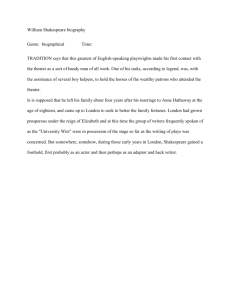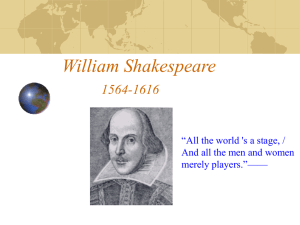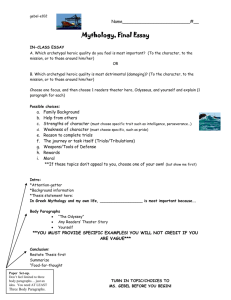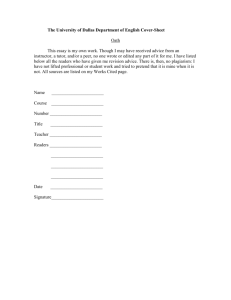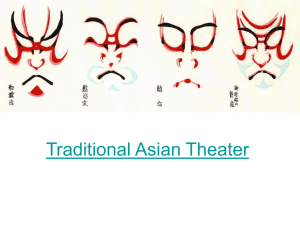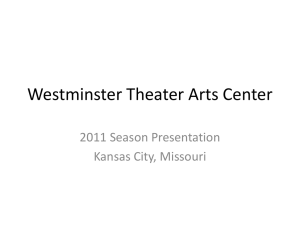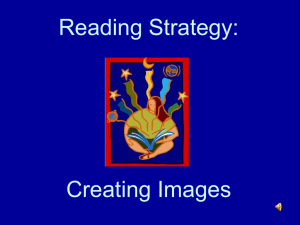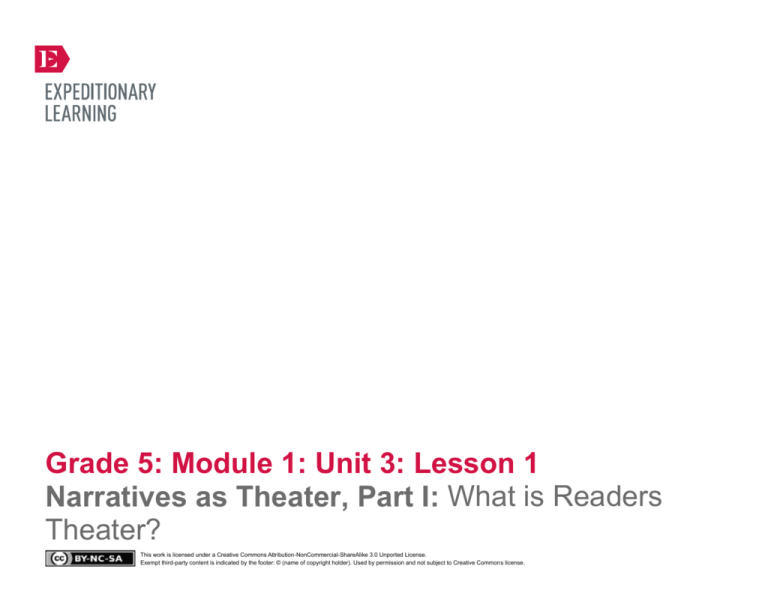
Grade 5: Module 1: Unit 3: Lesson 1
Narratives as Theater, Part I: What is Readers
Theater?
This work is licensed under a Creative Commons Attribution-NonCommercial-ShareAlike 3.0 Unported License.
Exempt third-party content is indicated by the footer: © (name of copyright holder). Used by permission and not subject to Creative Commons license.
GRADE 5: MODULE 1: UNIT 3: LESSON 1
Narratives as Theater, Part I:
What is Readers Theater?
Long-Term Targets Addressed (Based on NYSP12 ELA CCLS)
I can use a variety of sources to develop an understanding of a topic. (RI.5.9)
I can write or speak about a topic using information from a variety of sources. (RI.5.9)
I can adapt my speech for a variety of contexts and tasks, using formal English when appropriate. (SL.5.6)
I can recognize the differences between different types of narratives (poetry, drama, or other texts) and their connections to larger concepts such as culture and personal
experiences. (W.5.11)
Supporting Learning Targets
Ongoing Assessment
• I can define Readers Theater.
• Anchor chart: Readers Theater Definition and Purpose
• I can identify the purpose of Readers Theater.
• Participation in a Readers Theater
• I can participate in a Readers Theater.
• I can identify how a Readers Theater script differs from a novel.
Copyright © 2013 by Expeditionary Learning, New York, NY. All Rights Reserved.
NYS Common Core ELA Curriculum • G5:M1:U3:L1 • April 2014 •
CCI Enhanced Module (Homer Central Schools, Lyndonville Central Schools) May 2015
1
GRADE 5: MODULE 1: UNIT 3: LESSON 1
Narratives as Theater, Part I:
What is Readers Theater?
Agenda
Teaching Notes
1. Opening
• Remember, students have spent all of Unit 2 reading Esperanza Rising: “first draft reading” of all
chapters for homework and more careful study of specific passages from each chapter during class.
Thus, Unit 3 is the third read of Esperanza Rising, offering struggling readers an additional opportunity
to work with this complex text to further support comprehension of the material. This also provides
students an opportunity to go deeper with their analysis in the more creative form of Readers
Theater.
A. Review Learning Targets and Vocabulary (5 minutes)
B. Engaging the Reader: I Notice/I Wonder Anchor Chart (5
minutes)
2. Work Time
A. Defining Readers Theater by Reading Informational
Texts (15 minutes)
B. Participating in a Readers Theater: “American Heroes”
(30 minutes)
3. Closing and Assessment
A. Revisit the Readers Theater: I Notice/I Wonder Anchor
Chart (5 minutes)
4. Homework
• In advance: Read about Readers Theater, what it is and how it is done.
• In advance: Teachers either locate a video online of a reader’s theater
(http://www.aaronshep.com/rt/) or teacher gathers other teachers/students to perform a reader’s
theater (optional free scripts found at http://www.thebestclass.org/rtscripts.html to show students
as a model for what is to come.
• Read through the Readers Theater scripts, “American Heroes” 1–4.
• Review: Think-Pair-Share protocol (see Appendix 1).
• Review: I Notice/I Wonder anchor chart (see Appendix 2).
• Consider creating an Interactive Word Wall to use throughout this unit (see Appendix 1).
Lesson Vocabulary
Materials
define, purpose, narrative, Readers
Theater, script, novel, participate,
role
• What is Readers Theater? (and How Do You Really Spell It?) (one per student)
• Readers Theater definitions (one per student)
• Readers Theater rubric (one per student)
• “American Heroes” Scripts 1–4 (one per student)
• Highlighters (4 different colors)
• Anchor chart: Human Rights Challenges in Esperanza Rising (begun in Unit 2, Lesson 3)
• I Notice/I Wonder anchor chart (new; teacher-created)
Copyright © 2013 by Expeditionary Learning, New York, NY. All Rights Reserved.
NYS Common Core ELA Curriculum • G5:M1:U3:L1 • April 2014 •
CCI Enhanced Module (Homer Central Schools, Lyndonville Central Schools) May 2015
2
GRADE 5: MODULE 1: UNIT 3: LESSON 1
Narratives as Theater, Part I:
What is Readers Theater?
Opening
Meeting Students’ Needs
A. Reviewing Learning Targets and Vocabulary (5 minutes)
• ELLs may be unfamiliar with
academic vocabulary words (e.g.,
design, participate, identify.
Clarify vocabulary with students
as needed.
• Discuss the learning targets with students and clarify any vocabulary, as needed. Focus on the word purpose: the reason for
doing something. Invite students to think about the many ways they have thought about purpose throughout this module (e.g.,
the “purpose” of the UDHR: why it was written; the “purpose” of specific language the author chose in Esperanza Rising).
• Ask students to consider what question word goes most closely with thinking about purpose. Listen for students to focus on the
word “why.” Tell students that throughout Unit 3, they will be thinking about why authors make the choices they do to engage
their readers/listeners.
B. Engaging the Reader: I Notice/I Wonder Anchor Chart (5 minutes)
• Ask students to think about connections they have made between the novel Esperanza Rising and the UDHR (refer them back to
the anchor chart Human Rights Challenges in Esperanza Rising, from Unit 2). Have students Think-Pair-Share their
connections. Invite several students to share aloud the connections their partner made.
• Tell students: “You know the novel Esperanza Rising is a narrative. Reading narratives helps us understand the human
experience. Often the themes of novels relate to issues in the real world. We have been connecting the themes in Esperanza
Rising to the ideas found in the UDHR, an informational text.
* “In this unit, we will keep making connections to themes related to human rights. But we are going to learn about another type
of narrative, called a script. A script is used when actors and actresses perform a play, movie, or radio show. I am going to
show you some scripts, and we are going to read about them. By the end of the day, you will be clear about what a script is, and
how it is different from a novel. And we will start thinking about why an author would choose one instead of the other.
* “We will be reading narrative scripts over the next few days, and eventually you will be working in groups to write your own
scripts about scenes from Esperanza Rising that relate to specific articles in the UDHR.”
• Post the I Notice/I Wonder anchor chart and display a copy of one of the “American Heroes” scripts. Allow students a
moment to skim and scan the script quickly, then turn and talk with a partner about what they “notice” about the script (e.g.,
character names, a narrator, etc.). Have students share out their ideas as the teacher references the I Notice column of the chart.
Next ask students what they “wonder” about this script, and teacher references the I Wonder column of the chart. Keep this chart
posted for student reference throughout Unit 3. Teacher can go back and add after.
Copyright © 2013 by Expeditionary Learning, New York, NY. All Rights Reserved.
NYS Common Core ELA Curriculum • G5:M1:U3:L1 • April 2014 •
CCI Enhanced Module (Homer Central Schools, Lyndonville Central Schools) May 2015
3
GRADE 5: MODULE 1: UNIT 3: LESSON 1
Narratives as Theater, Part I:
What is Readers Theater?
Work Time
Meeting Students’ Needs
A. Defining Readers Theater by Reading Informational Texts (15 minutes)
• Visuals can help ELLs and other
students comprehend questions
and discussions. Chart main
points in answers and post all
questions asked to students.
• Tell students: “You just got to look quickly at the narrative script called ‘American Heroes.’ Later today, we will actually get to
participate in a Readers Theater using this script. First, you will need to understand what Readers Theater is.” Invite them to
think about and share with a partner what they predict the definition will include.
• Distribute and display the page titled What Is Readers Theater? (and How Do You Really Spell It?) Say: “Let’s read the following
definition together.” Read through this definition line by line, aloud, for students. Pause at the end of each sentence to clarify
difficult vocabulary (e.g., minimal, framework, dramatic, suggestive, partial, neutral, uniform, memorization, etc.).
• Ask students to Think-Pair-Share to add to the I Notice/I Wonder anchor chart. When possible, affirm how much they had
already figured out just by looking at an example of a script themselves.
• Next, distribute and display the Readers Theater Definitions sheet. Read each definition aloud (as time permits), pausing after
each to clarify any vocabulary. Then ask students to think and then talk with a partner, restating the definition in their own
words.
• Consider partnering an ELL
with a student who speaks the
same L1 when discussion of
complex content is required.
This can let students have more
meaningful discussions and
clarify points in their L1.
• Once finished reading several, or all, of the definitions, return students’ attention to the I Notice/I Wonder anchor chart and
have several students share any additional “notices” and/or “wonders” they have about Readers Theater, based on the definitions
they just read.
• Listen for students to make comments about the main aspects of a script.
– It includes the list of characters.
– It shows what words each person is supposed to say.
– It gives other instructions.
Copyright © 2013 by Expeditionary Learning, New York, NY. All Rights Reserved.
NYS Common Core ELA Curriculum • G5:M1:U3:L1 • April 2014 •
CCI Enhanced Module (Homer Central Schools, Lyndonville Central Schools) May 2015
4
GRADE 5: MODULE 1: UNIT 3: LESSON 1
Narratives as Theater, Part I:
What is Readers Theater?
Work Time (continued)
Meeting Students’ Needs
B. Participating in a Readers Theater: “American Heroes” (30 minutes)
• For any students who may be
shy about performing, help
them identify shorter passages
to read; have them focus on
“acting out” the line (with facial
expression and movement)
while another student reads the
line; allow time for the student
to read through his/her line
several times until comfortable
reading the line aloud.
• Tell students that today they are just going to try Readers Theater a bit. The goal today is just to give them a feel for how to read
the script, how speaking roles alternate, etc. Be sure students know that this is not in any way supposed to be a polished
performance, and that they are not being evaluated on their speaking or acting skills. They are just getting their feet wet.
• Display the Readers Theater rubric. Read and discuss the expectations for students’ delivery, cooperation with the group, and
on-task participation. Clarify any terms as necessary.
• Show a quick video or performance of a Readers Theater for students to parallel the expectations set forth of them. Options
included in the teaching notes at the top of the lesson. After the model is finished, have students turn and talk about what they
noticed concerning delivery and cooperation/participation among the group.
• Divide students into groups of four and distribute one of the “American Heroes” scripts to each group (scripts 1–4), along with
four different colored highlighters.
• Prepare: Assign each student in the group a role (or allow students 1 minute to decide which role each student will perform),
and have each student highlight (in a different color) the lines for which each is responsible.
• Practice: Allow students several minutes to practice their scripts, reminding them to pay attention to when it is each student’s
turn to speak and to refer to the Readers Theater rubric for expectations.
• Teacher could find a short video
of a reader’s theater to show as
a model to help students
comprehend better.
• Perform: Remind students that the purpose of today’s lesson is just to get a “feel” for Readers Theater. Ask for groups that are
willing to perform their script for the class.
• As time allows, ask students in the audience to offer brief feedback to the performers, based on elements of the rubric.
Copyright © 2013 by Expeditionary Learning, New York, NY. All Rights Reserved.
NYS Common Core ELA Curriculum • G5:M1:U3:L1 • April 2014 •
CCI Enhanced Module (Homer Central Schools, Lyndonville Central Schools) May 2015
5
GRADE 5: MODULE 1: UNIT 3: LESSON 1
Narratives as Theater, Part I:
What is Readers Theater?
Closing and Assessment
Meeting Students’ Needs
A. Revisit the Readers Theater: I Notice/I Wonder Anchor Chart (5 minutes)
• For students needing additional
supports producing language,
consider offering a sentence
frame, sentence starter, or cloze
sentence to provide the
structure required.
• Bring students back together in a whole group. Ask students:
* “Now that you have participated in a Readers Theater, what would you like to add to the I Notice side of our anchor chart?”
* “Can we cross out any of the I Wonder statements, because we have answers to those questions?”
* “What needs to be added to the I Wonder column of the anchor chart?”
• Leave this anchor chart posted for student reference throughout this unit.
Homework
Meeting Students’ Needs
• Explain Readers Theater to someone at home. Tell that person what you will be doing in class during this unit. Invite him or her
to see you perform in two weeks!
• For students who may need
help explaining the Readers
Theater and invitation orally to
someone at home, provide a
written note for the student to
give to his or her guest.
Note: For Lesson 2, read through the “Esperanza Rising” Readers Theater script, then break it into smaller scripts by
choosing sections 3-4 pages long, with 4-5 roles per section. Logical breaks are typically with Narrator lines, change in
setting, or change in time. The downloadable PDF of the script is available at http://pammunozryan.com/, lo cated by
clicking on the “Resources” tab.
Note: Also read and familiarize yourself with the full description of the performance task students will need to perform at
the end of this unit in order to support students’ work toward the goal of writing and pe rforming their own Readers
Theater scripts.
Copyright © 2013 by Expeditionary Learning, New York, NY. All Rights Reserved.
NYS Common Core ELA Curriculum • G5:M1:U3:L1 • April 2014 •
CCI Enhanced Module (Homer Central Schools, Lyndonville Central Schools) May 2015
6
Grade 5: Module 1: Unit 3: Lesson 1
Supporting Materials
This work is licensed under a Creative Commons Attribution-NonCommercial-ShareAlike 3.0 Unported License.
Exempt third-party content is indicated by the footer: © (name of copyright holder). Used by permission and not subject to Creative Commons license.
GRADE 5: MODULE 1: UNIT 3: LESSON 1
What Is Readers Theater?
(and How Do You Really Spell It?)
Readers on Stage (excerpt, adapted from Aaron Shepard)
And Definitions from Various Authors
Readers Theater is really basic theater. The goal is to support reading and
performing literature. There are many styles of Readers Theater. Here are some
basic features of Readers Theater:
There is a narrator to help frame the dramatic presentation.
No full stage sets. If used at all, sets are simple.
No full costumes. If used at all, costumes just suggest the feel of the characters or
the costumes are really basic or all the same.
No full memorization. Scripts are used openly in performance.
Readers Theater was developed as an easy and good way to present literature in
dramatic form. Most scripts are adapted from literature.
“Readers Theater is a rehearsed group presentation of a script that is read aloud rather
than memorized.” (Flynn, 2004)
“Readers Theater is an interpretive activity in which children practice and perform for others a
scripted reading.” (Rinehart, 1999)
“Readers Theater is dramatic oral expression that focuses on reading aloud rather than
memorization.” (O’Neill, 2001)
“Readers Theater is an interpretive reading activity in which readers use their voices to
bring characters to life.” (Martinez, Roser, and Strecker, 1999)
“The goal of Readers Theater is to read a script in which the story theme and character
development are conveyed to the audience through intonation, inflection, and fluency.”
(McAndrews, 2004)
Copyright © 2013 by Expeditionary Learning, New York, NY. All Rights Reserved.
NYS Common Core ELA Curriculum • G5:M1:U3:L1 • April 2014 • 8
CCI Enhanced Module (Homer Central Schools, Lyndonville Central Schools) May 2015
GRADE 5: MODULE 1: UNIT 3: LESSON 1
Definitions of Readers Theater
Various Authors
Copyright © 2013 by Expeditionary Learning, New York, NY. All Rights Reserved.
NYS Common Core ELA Curriculum • G5:M1:U3:L1 • April 2014 • 9
CCI Enhanced Module (Homer Central Schools, Lyndonville Central Schools) May 2015
GRADE 5: MODULE 1: UNIT 3: LESSON 1
I Notice/I Wonder Anchor Chart
Notices
Copyright © 2013 by Expeditionary Learning, New York, NY. All Rights Reserved.
Wonders
NYS Common Core ELA Curriculum • G5:M1:U3:L1 • April 2014 • 10
CCI Enhanced Module (Homer Central Schools, Lyndonville Central Schools) May 2015
GRADE 5: MODULE 1: UNIT 3: LESSON 1
Readers Theater Script: “American Heroes”
Individual
Scores
1–Needs
Improvement
2–Fair
3–Good
4–Excellent
Delivery
Student had
difficulty reading
the script and
consistently did
not use
expression, eye
contact, or props
appropriately
Student read the
script but had
little expression,
few gestures, little
eye contact, or
did not use props
appropriately
Student read the
script with some
expression,
gestures, eye
contact, and use
of props
Student read the
script with
confidence and
expression,
made gestures
and good eye
contact, and
used props to
add to the
performance
Cooperation
with group
Student did not
work
cooperatively
together with
group and could
not agree on what
to do. Student did
not share
responsibilities or
ideas and wasted
time
Student worked
cooperatively
with group in
some aspects of
the project but
sometimes could
not agree on what
to do and wasted
time
Student worked
cooperatively
with group in
most aspects of
the project and
shared most
responsibilities
and ideas
Student worked
cooperatively
with the group
in all aspects of
the project and
shared all
responsibilities
and ideas well
Group Scores
1–Needs
Improvement
2–Fair
3–Good
4–Excellent
On-task
participation
Low level of
active
participation
from majority of
group members
Moderate level of
on-task work or
few of the group
members actively
participating
Majority of
group members
on-task and
actively
participating
High level of
active, on-task
participation
from all group
members
Copyright © 2013 by Expeditionary Learning, New York, NY. All Rights Reserved.
NYS Common Core ELA Curriculum • G5:M1:U3:L1 • April 2014 • 11
CCI Enhanced Module (Homer Central Schools, Lyndonville Central Schools) May 2015
GRADE 5: MODULE 1: UNIT 3: LESSON 1
Readers Theater Script: “American Heroes”
Script 1 - Cast:
Narrator
Paul Revere
Frederick Douglass
Susan B. Anthony
Narrator: Today, you will be introduced to three American heroes. Their stories begin at different
times in history and in different places; however, you are learning about them because they have
made important contributions to our country. I will let them introduce themselves to you.
Paul Revere: Hi, my name is Paul Revere. It is a French name, because my parents were born in
France. My father came to North America in 1715 when he was thirteen years old. He settled in Boston.
He was a silversmith.
Frederick Douglass: Good day, my name is Frederick Douglass. I was born in Maryland in
February of 1818. Unlike Paul Revere, I was born into slavery, but I managed to gain my freedom by
boarding a train to New York.
Susan B. Anthony: Hello, my name is Susan B. Anthony, and I was born in Massachusetts on
February 15, 1820, two years after Frederick Douglass. Douglass and I actually knew each other. We
were both fighting for the same cause. We wanted freedom for all people. I grew up during a time
when women had very few rights.
"American Heroes: Reader's Theater Script." Wheelerville Union Free School.
Web http://www.wufsk8.com/wp-content/uploads/2012/09/American-Heroes-Readers-Theater-script-1-1.doc
Copyright © 2013 by Expeditionary Learning, New York, NY. All Rights Reserved.
NYS Common Core ELA Curriculum • G5:M1:U3:L1 • April 2014 • 12
CCI Enhanced Module (Homer Central Schools, Lyndonville Central Schools) May 2015
GRADE 5: MODULE 1: UNIT 3: LESSON 1
Readers Theater Script: “American Heroes”
Script 2 - Cast:
Narrator
Paul Revere
Frederick Douglass
Susan B. Anthony
Narrator: Listen as these three American heroes tell how they impacted our history and expanded
our rights and freedoms.
Paul Revere: Well, when I grew up, America was not the same as we know it today. There were only
thirteen colonies, and we were ruled by the British. We did not have 50 states like we do now.
Frederick Douglass: And, when I was born, America was no longer ruled by the British, but things
were still pretty bad. As I said before, I was born into slavery. It was illegal for slaves like me to learn
how to read, but I didn’t let that stop me. My first teacher was Sophia Auld. She was kind to me.
Susan B. Anthony: Well, although I was not a slave, I did not like the way some people were treated,
especially women. They did not have the right to vote, to own property, or to get good jobs. So, I
decided take a stand against the mistreatment of women.
Paul Revere: All of us had something we wanted to fight for. I decided that I was going to fight
against the British for our independence. I learn a lot from the men and women who came to our
silversmith shop. I heard stories about the complaints the colonists had against the British
government, so, I joined a group called the Sons of Liberty.
Frederick Douglass: And I hated being enslaved, so I dressed up as a sailor and got aboard a train
headed north. I was afraid I would be caught, but I got lucky and was able to make it to New York.
Susan B. Anthony: Well, I became a principal of an all-girls school, but I wanted to do more than
that. I wanted to work for justice and fairness for all the people who were being treated badly.
"American Heroes: Reader's Theater Script." Wheelerville Union Free School.
Web http://www.wufsk8.com/wp-content/uploads/2012/09/American-Heroes-Readers-Theater-script-1-1.doc
Copyright © 2013 by Expeditionary Learning, New York, NY. All Rights Reserved.
NYS Common Core ELA Curriculum • G5:M1:U3:L1 • April 2014 • 13
CCI Enhanced Module (Homer Central Schools, Lyndonville Central Schools) May 2015
GRADE 5: MODULE 1: UNIT 3: LESSON 1
Readers Theater Script: “American Heroes”
Script 3 - Cast:
Narrator
Paul Revere
Frederick Douglass
Susan B. Anthony
Narrator: So, what were some of the things that made you guys famous?
Paul Revere: Ah, well, let me see. I know you have heard about the famous Boston Tea Party, right?
Anyway, this was when the colonists decided that they were going to protest the taxes that the British
were making them pay. You know what they did? They dumped all the British tea into the Boston
Harbor.
Frederick Douglass: Oh boy, I bet that made them angry! But what I did was even more interesting.
I gave hundreds of speeches on the evils of slavery. I also became part of the Underground Railroad
that helped other slaves escape to freedom. I was a famous abolitionist. That just means someone who
wanted to get rid of slavery.
Susan B. Anthony: You were both very courageous! However, my good friend Elizabeth Stanton
and I formed the first political group for women, called The Women’s National Loyal League. We also
organized the National Woman Suffrage Association. Suffrage means the right to vote.
"American Heroes: Reader's Theater Script." Wheelerville Union Free School.
Web http://www.wufsk8.com/wp-content/uploads/2012/09/American-Heroes-Readers-Theater-script-1-1.doc
Copyright © 2013 by Expeditionary Learning, New York, NY. All Rights Reserved.
NYS Common Core ELA Curriculum • G5:M1:U3:L1 • April 2014 • 14
CCI Enhanced Module (Homer Central Schools, Lyndonville Central Schools) May 2015
GRADE 5: MODULE 1: UNIT 3: LESSON 1
Readers Theater Script: “American Heroes”
Script 4 - Cast:
Narrator
Paul Revere
Frederick Douglass
Susan B. Anthony
Narrator: That is all wonderful, but what else did you do?
Paul Revere: Well, I became famous for the midnight ride that I took from Boston to the towns of
Lexington and Concord, Massachusetts. I had to warn the Patriot Militia that the British soldiers were
coming. I was riding with William Dawes and Samuel Prescott. The battle at Lexington was the first
battle of the American Revolution. When the war ended in 1783, the thirteen colonies had gained
independence. We became the United States of America.
Frederick Douglass: I started a newspaper called the North Star, and I worked with Susan B.
Anthony and many others to end slavery and get more rights for women. President Lincoln and I
became friends, because he was against slavery as well.
Susan B. Anthony: Well, I am proud to say that I was arrested for voting. And, because of my
diligence, by 1920, the law was changed to allow women in every state to vote. So, every time you cast
a vote, think of me!
Frederick Douglass: Hey, hey, don’t forget, I am the first African American to get my picture on a
postage stamp!
Paul and Susan: Way to go, Frederick!
Narrator: Well, you are all famous! Thank you so very much for the contributions you have made to
our American history. Because of your diligence and courage, you have made us proud.
"American Heroes: Reader's Theater Script." Wheelerville Union Free School.
Web http://www.wufsk8.com/wp-content/uploads/2012/09/American-Heroes-Readers-Theater-script-1-1.doc
Copyright © 2013 by Expeditionary Learning, New York, NY. All Rights Reserved.
NYS Common Core ELA Curriculum • G5:M1:U3:L1 • April 2014 • 15
CCI Enhanced Module (Homer Central Schools, Lyndonville Central Schools) May 2015
GRADE 5: MODULE 1: UNIT 3: LESSON 1
Readers Theater Script: “American Heroes”
Copyright © 2013 by Expeditionary Learning, New York, NY. All Rights Reserved.
NYS Common Core ELA Curriculum • G5:M1:U3:L1 • April 2014 • 16
CCI Enhanced Module (Homer Central Schools, Lyndonville Central Schools) May 2015

